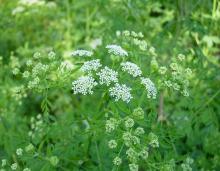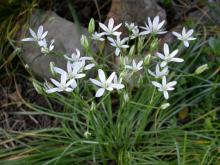Wildflowers, Grasses and Other Nonwoody Plants
Media

Species Types
Scientific Name
Ageratina altissima (formerly Eupatorium rugosum)
Description
White snakeroot looks very similar to thoroughworts, but it has triangular leaf blades that are more broadly angled or rounded at the base. White snakeroot is common statewide. It’s a toxic plant if eaten, so it’s good to be able to identify it.
Media

Species Types
Scientific Name
Apocynum cannabinum
Description
Indian hemp is a shrubby, upright perennial with opposite branches and milky sap. This native plant can be a troublesome weed in crop fields and gardens, but Native Americans used its tough, fibrous stems for rope-making.
Media

Species Types
Scientific Name
Solanum carolinense
Description
Horse nettle is a native perennial with spiny stems and leaves, white to purplish flowers, and toxic fruits that look like tiny yellow tomatoes. It does well in disturbed habitats, and many people consider it a weed.
Media

Species Types
Scientific Name
Cicuta maculata
Description
Full grown, water hemlock looks something like a gigantic Queen Anne's lace, but this common, widespread member of the carrot family is the most toxic plant in North America. All parts are deadly. A piece of root the size of a walnut can kill a cow-sized animal.
Media

Species Types
Scientific Name
Baptisia alba (formerly B. leucantha)
Description
White wild indigo is the tallest species of false indigo in Missouri. It has a robust, striking presence, with white flowers and a shrubby look. Look for it statewide, in prairies and glades and along roadsides, streams, and valleys.
Media

Species Types
Scientific Name
Ornithogalum umbellatum
Description
Star of Bethlehem is an introduced exotic plant that makes clusters of bright white flowers in the spring. It reproduces prolifically by forming a multitude of bulbs underground.
See Also
About Wildflowers, Grasses and Other Nonwoody Plants in Missouri
A very simple way of thinking about the green world is to divide the vascular plants into two groups: woody and nonwoody (or herbaceous). But this is an artificial division; many plant families include some species that are woody and some that are not. The diversity of nonwoody vascular plants is staggering! Think of all the ferns, grasses, sedges, lilies, peas, sunflowers, nightshades, milkweeds, mustards, mints, and mallows — weeds and wildflowers — and many more!





















